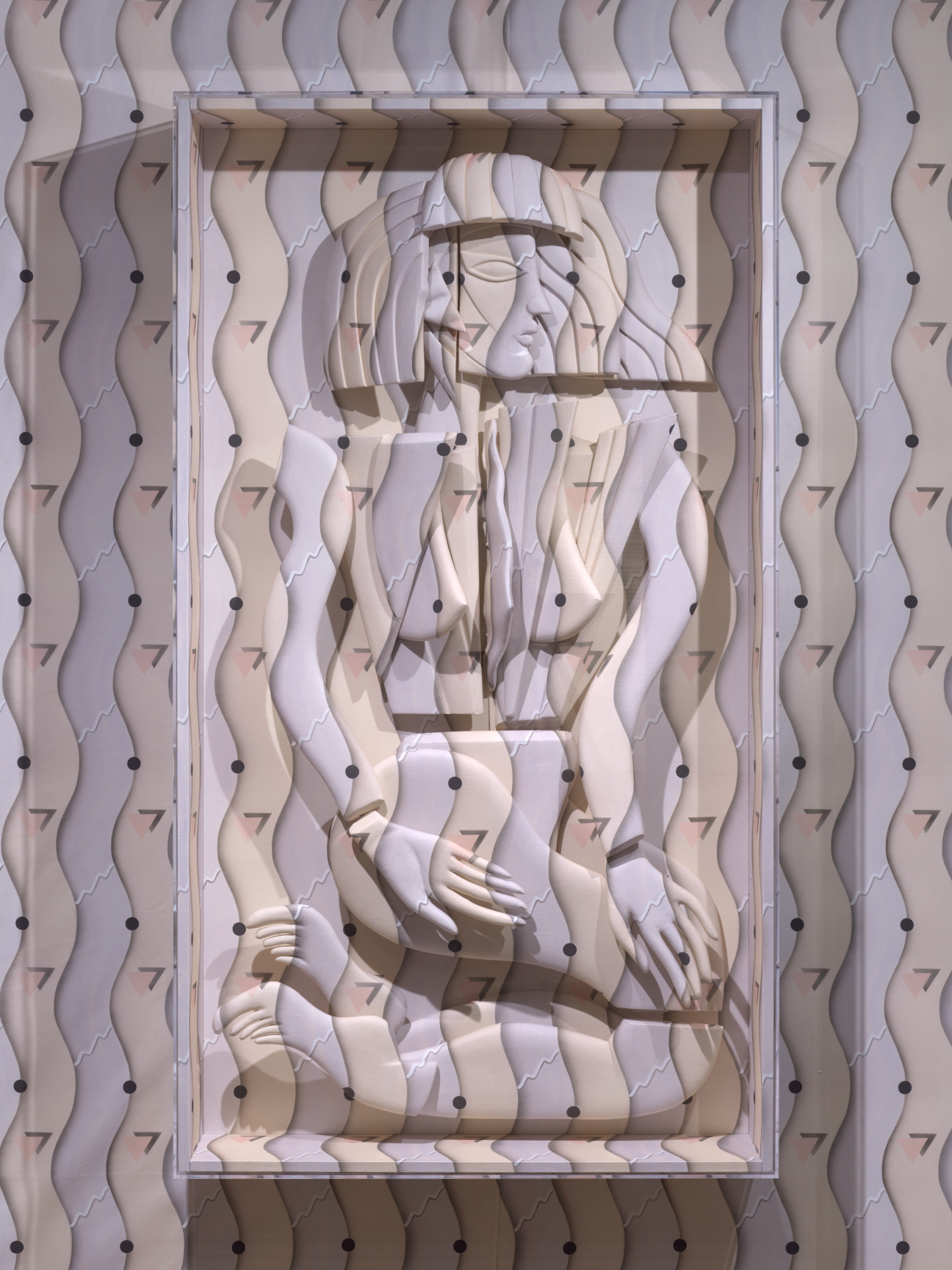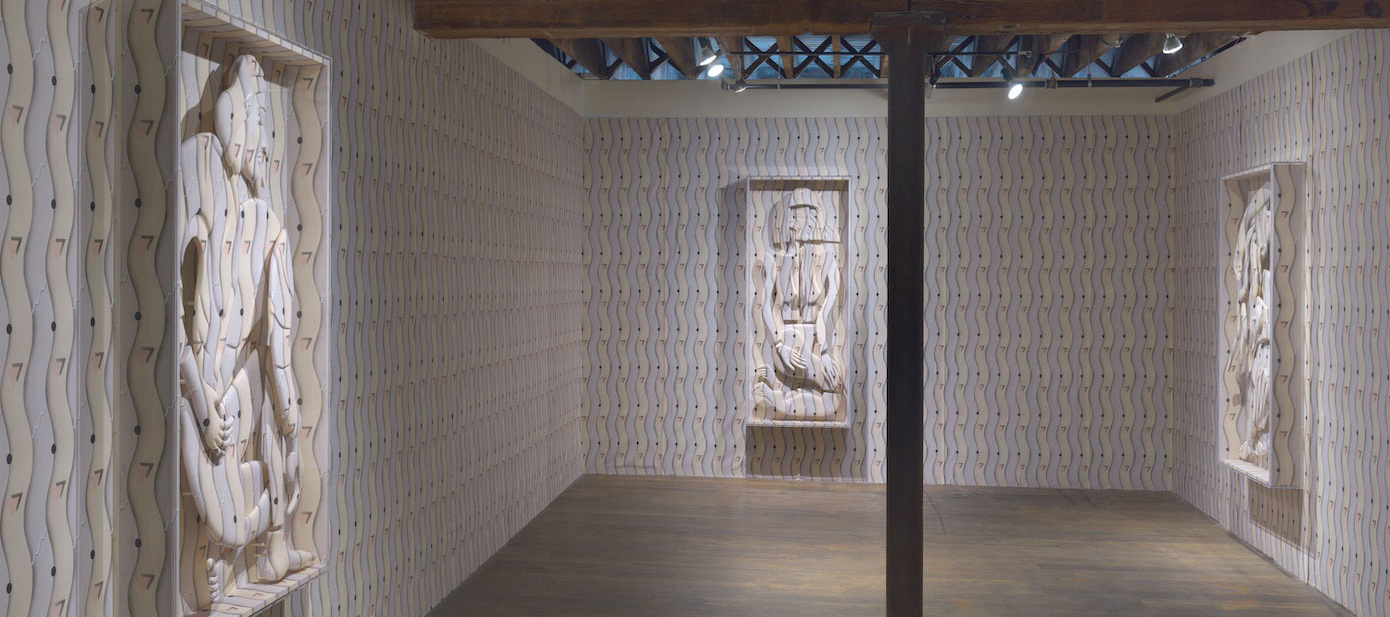Anya Kielar's "Shadow Box" on the second floor of Pioneer Works is a room draped in powder pink particles and greige-violet waves. From this pastel tapestry aether emerge three figures: The Guardian crouched and prowling; The Queen, clad in a fluted corset of armor; and The Amazon, bare and vulnerable with eyes closed. Each are portraits of an ethereal femininity central to Anya Kielar’s “Shadow Box,” their hair blowing in the cosmic wind.
Moving in closer, The Guardian has arms carved with lines that read like strength, assembled in a confident pose and ready for anything. The Queen gazes right. Her facial features are sharp and pointed, like her hair, like her corset, and like the triangle motif which dots the walls. The Amazon tilts her head up. Her arm is cast over her head, breasts and belly exposed. Her fingers meld with her loose, wavy hair and both oscillate with the same frequency as the pattern on the fabric and walls. The lively fabric lining the walls of the Brooklyn, New York gallery also adorns the figures to create an elaborately crafted optical illusion. Like a Magic Eye autostereogram, the figures pop out of their surroundings—Keilar has perfectly aligned their fabric inlay to merge seamlessly with the pattern on the wall. Overlaying the space with this Memphis-like pattern is a welcomed rejection of the white-walled gallery tradition, a choice that serves the work.
The show strikes a satisfying balance between "art for art’s sake" and social awareness. Her point is clear, but never ceases to be gorgeous or marvelously skillful in its execution. "As a woman, it’s hard to ignore how our bodies affect the way we experience the world,” Kielar explains. “It still feels important to keep pushing our perspective into art because it hasn’t been that long that we’ve been able to do that. A lot of the images we see growing up are by male makers. I’m just trying to establish my own approach to the female form and want my life experiences to find a way into my work." In this way, the artist isn’t too heavy-handed in how she conveys womanhood, or in making a feminist quip. Attentive to the intangible ways that a woman can be limited, her work remains lighthearted and is seriously clever.
The sculpted women Kielar presents for “Shadow Box” are literally boxed-in. They are compressed, bound by individual compartments clearly too small for their stature. Further, the artist has uniformly painted over her ladies, as if to flatten them and reduce them to decorative objects. The Guardian, The Amazon, and The Queen, however, remain awe-inspiring totems to a silent and feminine "soft power." They contort themselves into yogic postures, finding both ease and enunciation from within these constraints. "I think of my work as being portraits of modern women," says Kielar. "They are complex and beautiful but also aware of being looked at through that confining lens."

A born and raised New Yorker, Kielar, 44, earned her MFA from Columbia in 2005 and has worked in her characteristic shadow box format for well over a decade. She is curious about how to create meaning through collected and assembled objects. Whereas she used to work with found objects to explore female figuration, she now plays grand creator instead—a role often attributed to men. "I make all the components in my work now which means my hand has a role in every aspect of it," she says. The artist has carved flat-backed, bas relief pieces and parts, which by themselves feel two-dimensional, and brought them together to create multi-dimensional beings. Awash in the undulating pattern, these multilayered sculptures lie somewhere between animate and still—to delightfully psychedelic effect.
The marionette-like Queen, Amazon, and Guardian in “Shadow Box” are less like props and more like players themselves. The differences between each figure are s ubtle, which can make them seem like different facets of the same being rather than individuals themselves. This is in much the same way that Laxmi, Saraswati, and Parvati are different aspects of the same divine feminine presence. It feels like a double entendre, too, since women can of course be seen as women before they are seen as individuals. It’s hard to say for certain which archetype belongs to which sculpture, but this only adds to their spiritual mystique.
“Shadow Box” is on view at Pioneer Works until December 11, 2022, at 159 Pioneer Street, Brooklyn, New York 11231.





